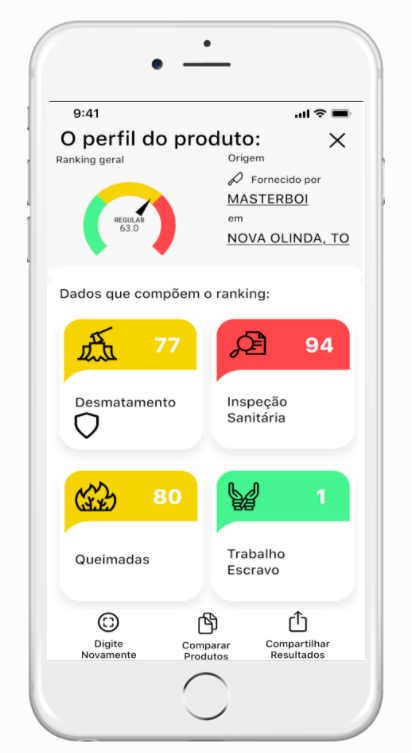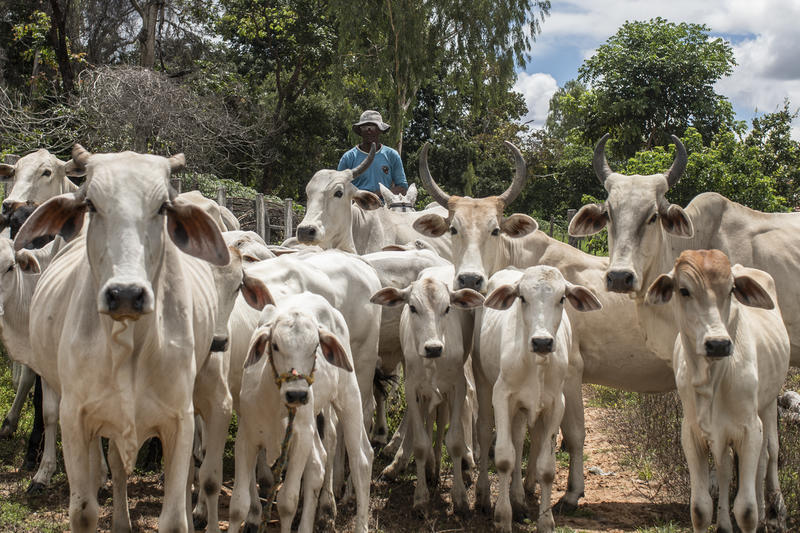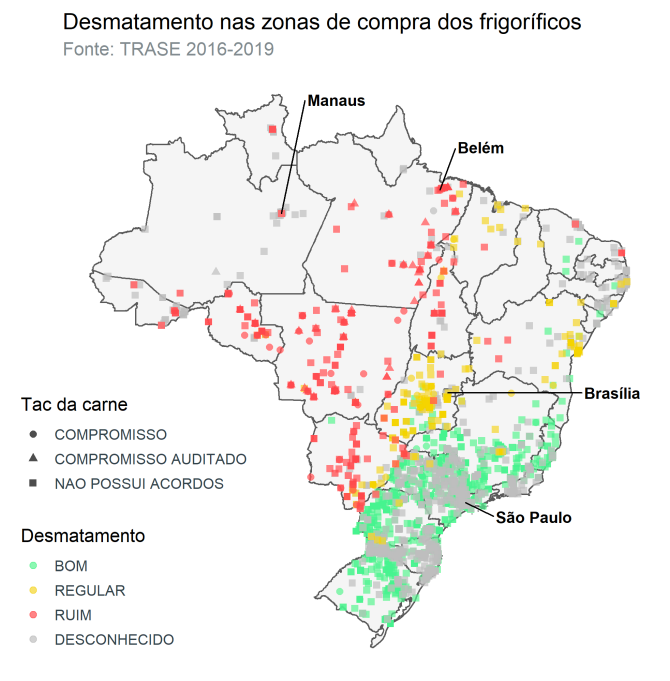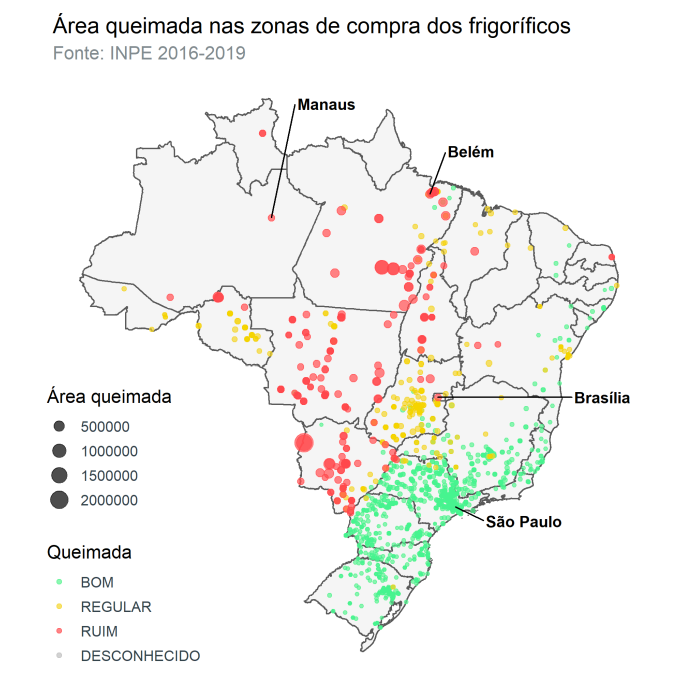The “From Pasture to Table” app maps a series of indicators to identify the sustainability of the beef consumed in Brazil. This citizen science tool depends on the active participation of consumers.
The Initiative
- Name
- App that classifies beef consumed in Brazil according to the sustainability of its production chain
- Who’s involved
- Trase, Universidade Católica de Louvain (Bélgica) and ONG Repórter Brasil
- What is it
- promotes conscious consumption by mapping and increasing the transparency of beef sold in supermarkets and commercial establishments
- Where is it
throughout Brazil
One of the most prominent rights in the 1990 Consumer Defense Code states that all Brazilians can choose the products and services they find most convenient. But without clear and detailed information on packaging and labels, the population could end up buying “a pig in a poke”, such as beef from farms involved in deforestation, slavery, and other federal crimes.
To encourage conscientious consumption, Trase, a global network that maps trade and financing of commodities, the Catholic University of Louvain (Belgium), and the NGO Repórter Brasil launched the mobile app “Do Pasto ao Prato” (“From Pasture to Table”). The technology – still under development (beta version) but already available for use – crosses public data on illegal deforestation, burning, fines for slave labor, and non-compliance with sanitary standards by slaughterhouses or farms to point out which meat products are more or less sustainable.
“We developed the tool because the vast majority of meat produced in Brazil is consumed in the country itself, and pastures are a major source of deforestation in the Amazon and other biomes. The app empowers consumers, allowing Brazilians to purchase products free of these impacts”, explained the biologist and co-creator of the app Vivian Ribeiro, a researcher at the Stockholm Environment Institute (Sweden).

To find out the “socio-environmental quality” of the meat they intend to buy, “From Pasture to Table” users can enter information about the product, including the SIF (federal seal for animal products), the type of meat, the name of the slaughterhouse, and the supermarket or commercial establishment. Then, the app ranks the product based on the indicators it evaluates, helping costumers decide on whether to purchase the product. The greener your classification, the less socio-environmental problems there are in the meat.
A study published in the journal PNAS (Proceedings of the National Academy of Sciences) pointed out that 80% of the meat produced in Brazil between 2015 and 2017 was consumed inside the country – only 20% was exported. Factors such as the economic crisis increased the percentage sold to other countries to 26% last year. “Deforestation and other problems are more associated with meat consumed in the country than exported products. The internal market is flexible to these products”, said Ribeiro.
Improving the transparency of this market has become a crucial issue, as damage to natural environments and to indigenous and traditional populations is “hidden” in long and complex meat supply chains. An analysis published on the platform “Amazon 2030” points out that large slaughterhouses process most of the meat produced in the region, where low productivity husbandry goes hand in hand with the criminal occupation of land.
Deforestation and other problems are more associated with meat consumed in the country than exported products. The internal market is flexible to these products
Vivian Ribeiro, researcher at the Stockholm Environment Institute
So far, the app monitors beef, but there are plans to track pork and chicken products as well. The tool uses federal information on the period between 2016 and 2019 and will soon add data from state agencies. The mapping is done through electronic Animal Transportation Guides (GTAs) records, a mandatory document for the transportation of live animals between farms and from them to slaughterhouses throughout the country.
Even with the compulsory use of guides, the supply chain tracking system still has flaws. “There is a concentration of GTAs in the slaughter and fattening cycles, but much less so at the ‘base of the pyramid’, in the transit of animals between farms and also from places with precarious infrastructure, such as rural settlements,” said Lisandro Inakake de Souza, Imaflora’s Climate and Agricultural Supply Chains coordinator. The institution maintains the “Boi na Linha” platform, which lends transparency to information to accelerate compliance with private agreements and with the Federal Prosecutor’s Office to reduce deforestation in meat production and trade, especially in the states of Pará, Mato Grosso, Amazonas, Rondônia and Acre.
The app’s creators solve possible failures in public information by analyzing deforestation and forest fire data in municipalities that directly and indirectly supply animals to slaughterhouses. Establishments that buy livestock from municipalities where there is a lot of deforestation to open pastures receive a lower classification.
Launched in August and for now available only on Android devices, the app has tracked more than 1,200 products, connecting them to about 300 slaughterhouses and 200 supermarkets. Over 1,000 people downloaded this “citizen science” tool. The app’s model uses information generated by the population for scientific purposes, in this case, mapping the paths taken by beef. Preliminary data indicate that ¼ of the meat consumed in Rio de Janeiro comes from the Legal Amazon. One of the challenges faced by “From Pasture to Table” is to increase its effective user base.
The obstacle is common in similar initiatives, evaluates researcher Alex Bager, coordinator of the Brazilian Center for Road Ecology at the Federal University of Lavras (MG), where Urubu Mobile (“Mobile Vulture”) was developed. Since 2014, the app has accrued over 25,000 users and 100,000 records of animals who were run over throughout the country’s highways. “At a certain time, we had 50,000 downloads, but only about 10% were effective users. Thinking that people will continue to help indefinitely is not realistic,” he tells us.
To increase engagement, Bager says that it is necessary to invest in updates and communication. “We use gamification techniques so that users have different levels according to their contribution in the app. Feedback is required with information-rich materials and accountability for the use of the data collected. Continuous investments in communication, development, and updating devour a large part of the budget for projects of this type, but this is how they are maintained and attract new audiences”, he highlighted.
According to researcher Vivian Ribeiro, issues like these are on the radar of the team responsible for “From Pasture to Table”. “Our planning involves making the tool even more attractive to different audiences, improving interaction with users and engagement with retailers and other private and public agencies,” he highlighted. An updated and more complete version of the app will be released in 2022.
How to get involved
- Project website
- https://dopastoaoprato.com.br/
download do aplicativo (Android)
- Contact information
- [email protected]
Top image shows a herd of cattle in Mato Grosso, Brazil’s largest beef producer. Photo: Victor Moriyama/Greenpeace





